Menus
- Seven 48 hp twins in a comparison test
- 4th8 hp twins in a comparison test
- Entry-level machines have never been more tempting
- Three novice drivers as co-testers
- Suzuki Gladius and Ducati Monster 696
- Gladius in personal ranking in second place
- Data and measured values
- Harley-Davidson 883 Roadster and Kawasaki W 800 SE
- Data and measured values
- Honda NC 700 X and BMW F 700 GS
- Data and measured values
- Honda CB 500 F.
- Data and measured values
- Test results and scoring
- MOTORCYCLE test results
- MOTORCYCLE scoring
- Tester opinions
- "Good seating ergonomics is not to be despised"
- "What counts: handy, low, not too heavy"
- "Actually, I’m into the retro look"
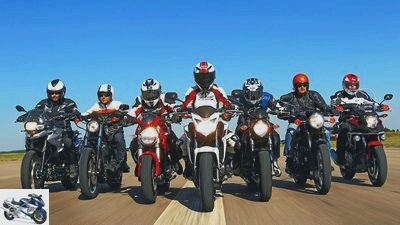
Bilski
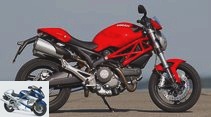
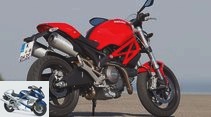
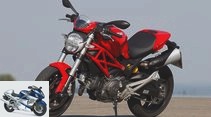
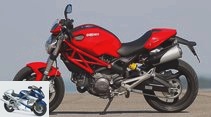
71 photos
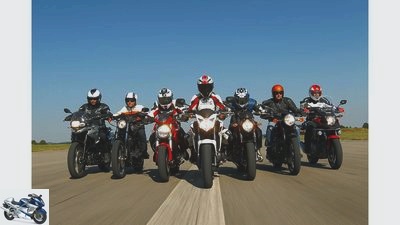
Bilski
1/71
Seven 48 hp twins from the manufacturers Honda, Ducati, Suzuki, Harley-Davidson, Kawasaki and BMW were tested.
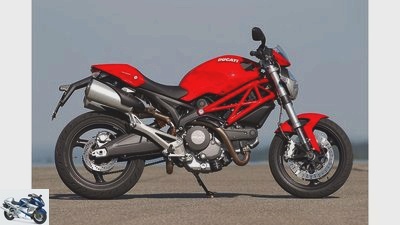
Bilski
2/71
Muscular, stocky. Cool manifold, fat aluminum swingarm.
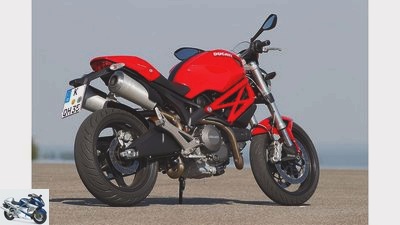
Bilski
3/71
Small, compact, full of character. Above all, the wiry Ducati is the lightest offer in the test field, it weighs only 185 kilograms.
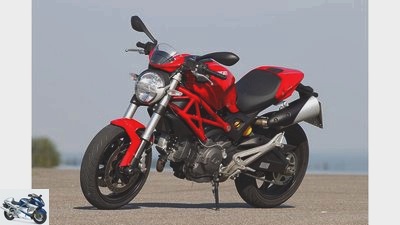
Bilski
4/71
20 years after the first Monster M 900, these include the massive aluminum swing arm and the fat upside-down fork, the only one of this type here in the test field.
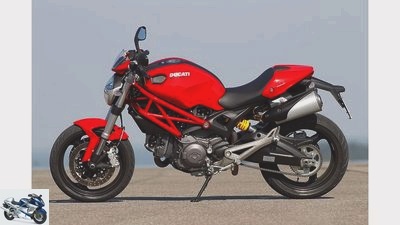
Bilski
5/71
The Ducati Monster 696 is characterized by fine workmanship. Despite its low price, it spoils you with elegant details.
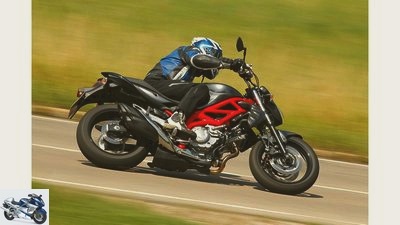
Bilski
6/71
For long journeys, the seat bench’s thigh support is a bit small, and the last bit of contact with the motorcycle is missing.
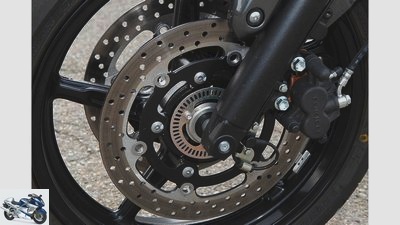
Bilski
7/71
Compared to the monsters’ brakes, the Gladius looks old.
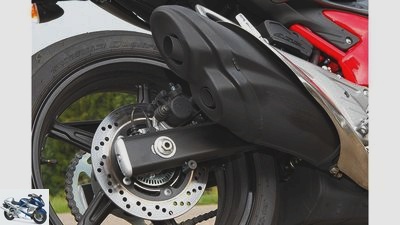
Bilski
8/71
At 100 km / h, the Gladius turns 4900 / min, the Monster only 4600 / min.
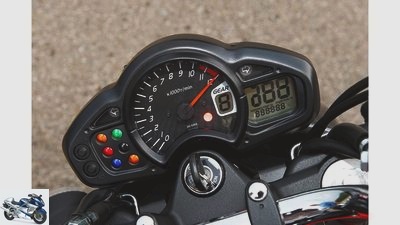
Bilski
9/71
Simply good. Clear cockpit with practical gear indicator, standard in the classic tachometer.
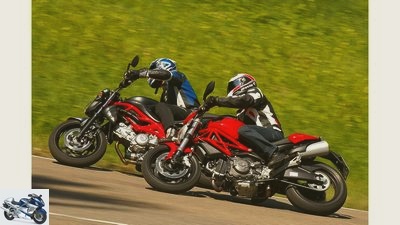
Bilski
10/71
The sporty: Suzuki Gladius, Ducati Monster 696
High driving dynamics? Both fiery lightweights offer not only open versions with a good 70 hp, but also throttled to 48 hp. Handy sweepers with 90-degree V-Zwos in fire-red tubular space frames.
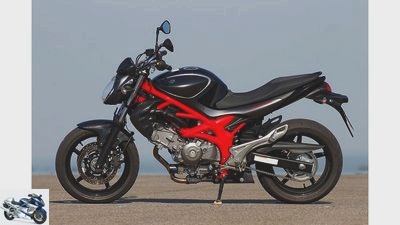
Bilski
11/71
Up to 5000 tours you hardly notice that the Suzuki Gladius is the 48 hp throttle version.
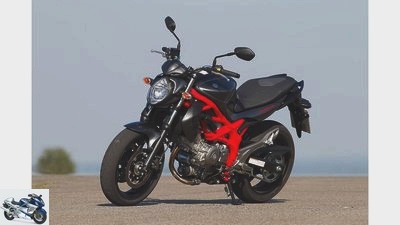
Bilski
12/71
The throttling by means of another control unit fits perfectly. Costs 160 euros plus ten minutes of working time.

Bilski
13/71
Rounded shapes, black painted damper, steel swing arm and simple fork.
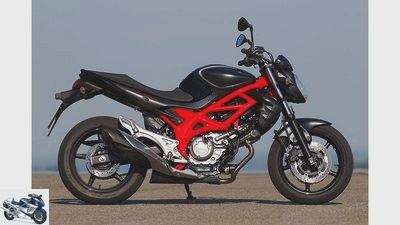
Bilski
14/71
The Suzuki has the highest performance of all seven machines on the rear wheel at the same speed.
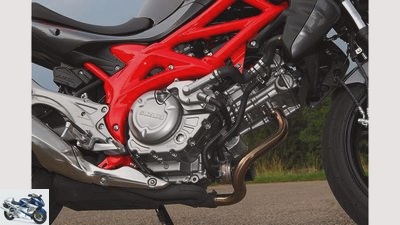
Bilski
15/71
Glittering. The fantastic V2 has silver paint, stainless steel elbows and long water hoses.

Bilski
16/71
Simply great: easy-to-use handwheel on the shock absorber. Damping regulates
electronically (ESA.
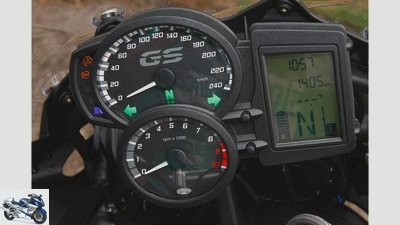
Bilski
17/71
Not ideal: highly reflective oval watches with thick hands. On-board computer with XXL gear indicator costs extra.

Bilski
18/71
The BMW is equipped with a two-cylinder four-stroke in-line engine.
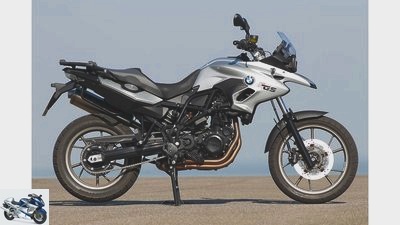
Bilski
19/71
He who is good and noble does not have to be beautiful. Great: comfort seat and tank in the rear.
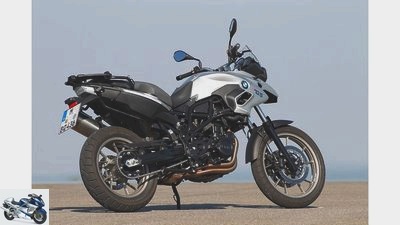
Bilski
20/71
With the additional equipment consisting of traction control, tire pressure monitoring, electronically adjustable damping on the shock absorber, main stand, heated grips, on-board computer, said comfort seat and Vario suitcases, the BMW has a full 218 kg combat weight.

Bilski
21/71
In addition to the comfort seat built in here, BMW offers both higher and lower benches.
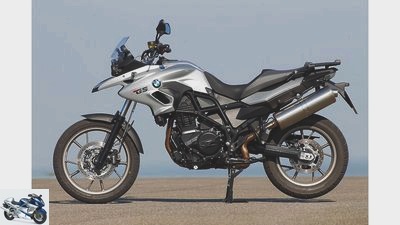
Bilski
22/71
The deeply stacked BMW F 700 GS has a full 798 cm³, so it’s a real 800.
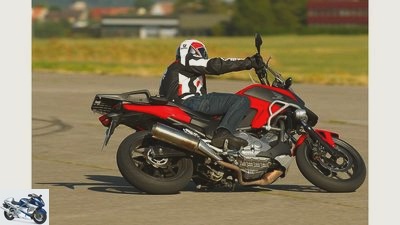
Bilski
23/71
The engine of the Honda pushes lively and smoothly from the lowest revs.

Bilski
24/71
The drive chain of the Honda NC 700 X.
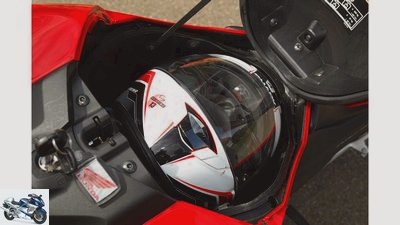
Bilski
25/71
So practical: the spacious helmet / luggage compartment in front of the chest. Possible because the tank is under the pillion seat.
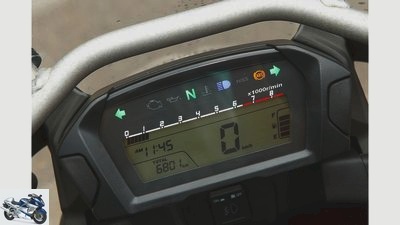
Bilski
26/71
Sober: the cockpit offers little charm and hardly any information. Really bad read: LCD tachometer.
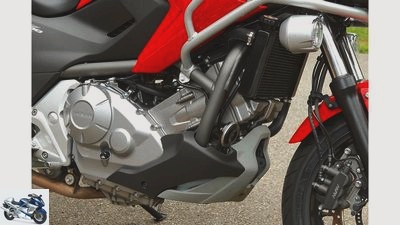
Bilski
27/71
The two-cylinder four-stroke in-line engine is behind a steel tubular cage.
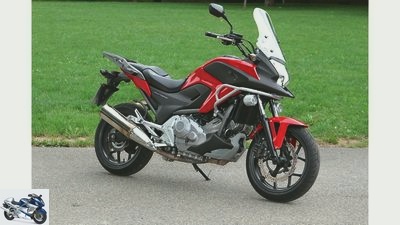
Blacksmith
28/71
Full dresser: Touring windshield, crash bars and additional lamps cost extra like the suitcase.
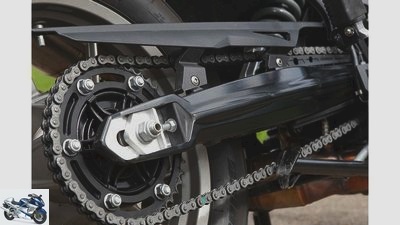
Bilski
29/71
The drive chain of the BMW F 700 GS.
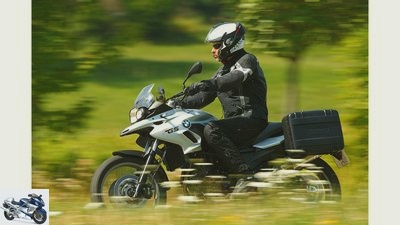
Bilski
30/71
BMW even gives newcomers a discount of 1,000 euros.
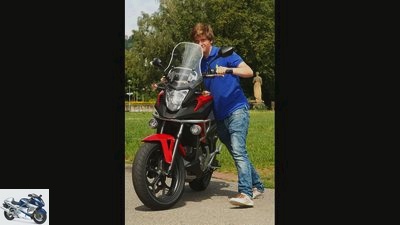
Bilski
31/71
When choosing the right motorcycle, you should think carefully about what to expect from the first bike. Easy to use? Pushing, maneuvering, jacking up. How big and heavy is the motorcycle, how high is its center of gravity?
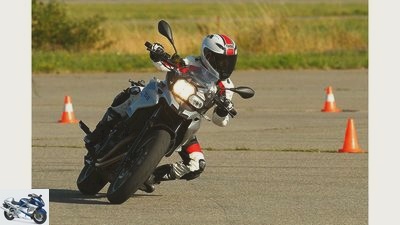
Bilski
32/71
The Honda built in Thailand drives well, really well.
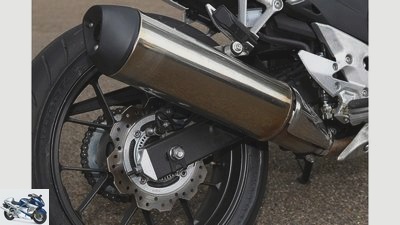
Bilski
33/71
The exhaust of the Honda CB 500 F.
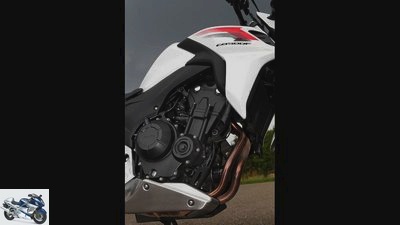
Bilski
34/71
The Honda CB 500 F is equipped with a two-cylinder four-stroke in-line engine.
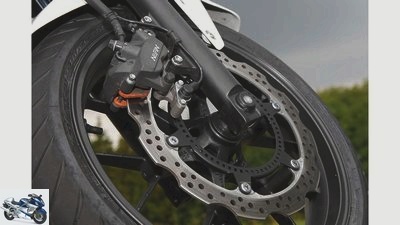
Bilski
35/71
Simple, but efficient – just like the whole motorcycle: the single pane has the 193 kilograms under control.
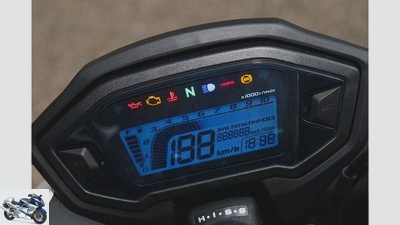
Bilski
36/71
LCD bar tachometers are Honda fashion. This one is fairly easy to read. Fine: mini on-board computer.
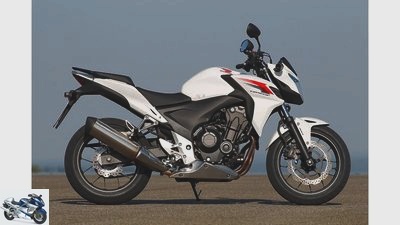
Bilski
37/71
In its own way, the highly agile 500 series conveys a lot of driving pleasure. So agile, so light, so easy. Extremely handy.
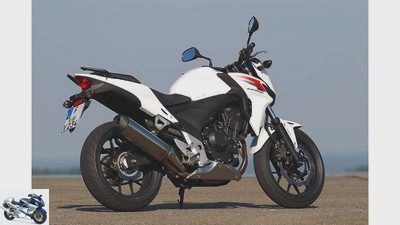
Bilski
38/71
The 500 is content with just over three liters of petrol per 100 kilometers.
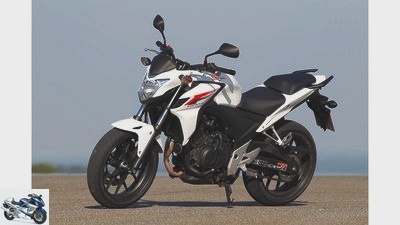
Bilski
39/71
Dynamically “swept”, the 500 already looks fast when stationary. A claim that she fully honors while driving.

Bilski
40/71
The mini-twin is just great, has plenty of reserves. Honda has completely redeveloped it, not just using the good engine of the CB 500 from the 90s.
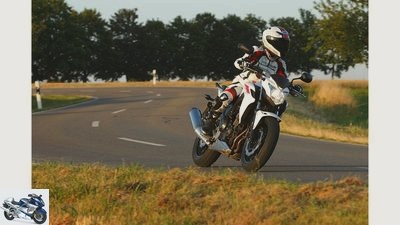
Bilski
41/71
The Honda CB 500 F is one of the agile 48er bikes.
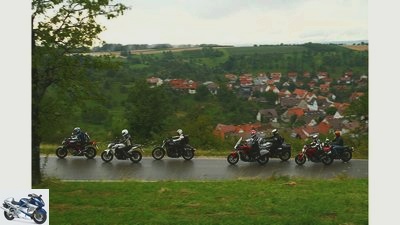
Bilski
42/71
Before you buy, you shouldn’t miss out on a detailed research – some manufacturers give novice drivers a huge discount that can influence the purchase decision.
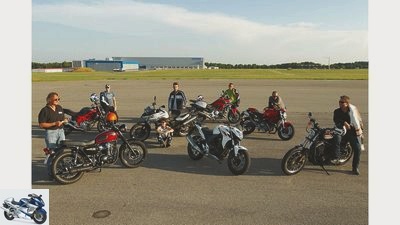
Bilski
43/71
Full broadside, sorry: bandwidth. Wide range of various twins.

Blacksmith
44/71
The Honda NC 700 X is satisfied with a total of 670 cubic meters.
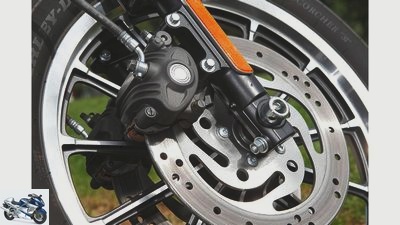
Bilski
45/71
Not that bad: double pane in front, single pane in back. Unfortunately, as with the W 800, there is still no safe ABS.
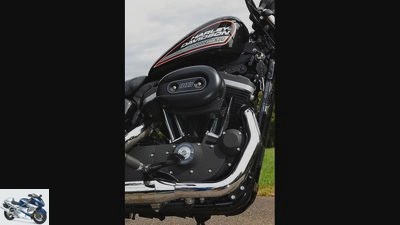
Bilski
46/71
The Harley 883 Roadster is equipped with a two-cylinder four-stroke 45 degree V-engine.
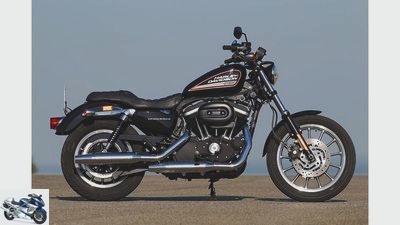
Bilski
47/71
Statement on wheels. Even the smallest Harley explains itself.
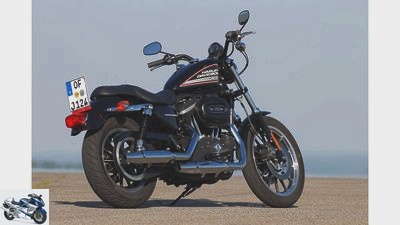
Bilski
48/71
The 883 embodies American heavy metal. Stable, solid, a real iron. The US paint looks thicker, the chrome shinier.
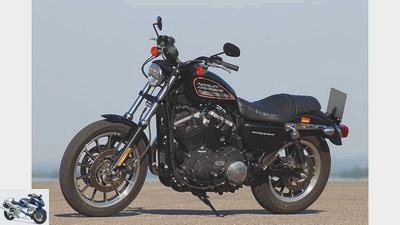
Bilski
49/71
The 883 is available for less than 9,000 euros.
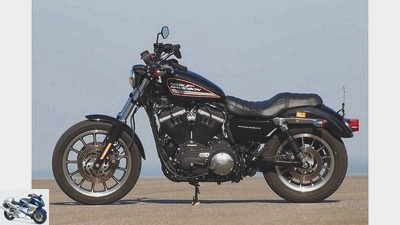
Bilski
50/71
The Harley-Davidson Sportster 883 Roadster embodies a class of its own: The American Way of Ride!
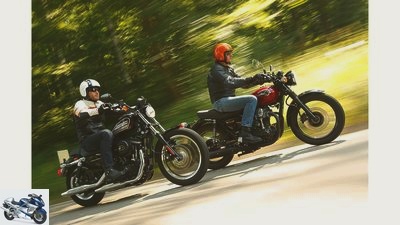
Bilski
51/71
The classic ones: Harley-Davidson 883 Roadster and Kawasaki W 800 SE
They bring past epochs back to life. Bewitching with familiar shapes and timeless elegance. Air-cooled, long-stroke and casual, the Harley and Kawasaki exude a charm that is less beguiling for beginners.

Bilski
52/71
The best motorcycle is of little use if it doesn’t suit you personally.
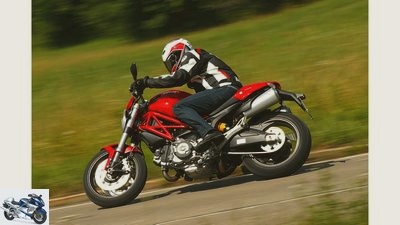
Bilski
53/71
Right from the start, the 650 V2 hangs wonderfully directly, sensitively on the gas.
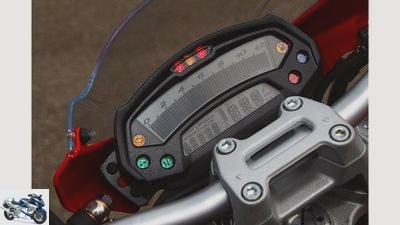
Bilski
54/71
Would be better. Bar tachometer and small LCD information are only moderately readable. Beautiful handlebar landscape.
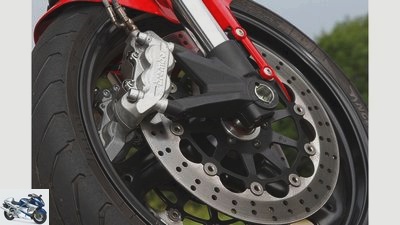
Bilski
55/71
The monster’s brake is great in terms of its effectiveness and controllability.
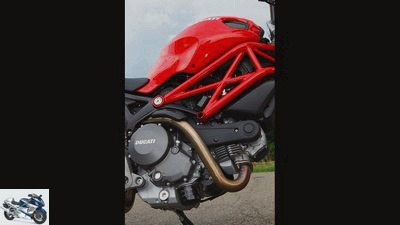
Bilski
56/71
The tubular space frame painted in fire red is made of steel.
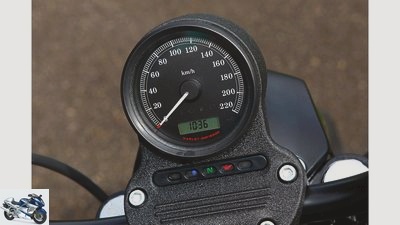
Bilski
57/71
Lonely: The speedometer is not flanked by a rev counter, and the needle is not very busy. Rudimentary info.
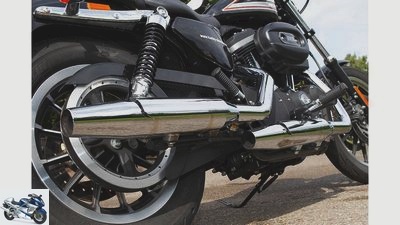
Bilski
58/71
The cost of throttling for the Harley-Davidson is 35 euros. The working time is approx. 1.5-2 working hours.
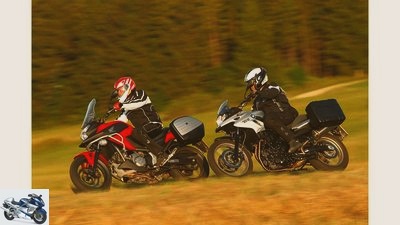
Bilski
59/71
The Honda NC 700 X and the BMW F 700 GS are suitable for everyday use.

Bilski
60/71
To be honest: entry-level motorcycles have never been more attractive than they are today!
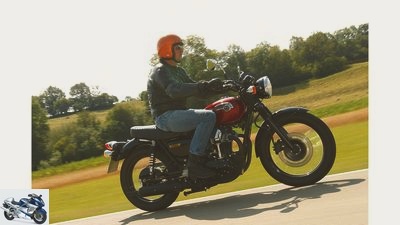
Bilski
61/71
With the Kawasaki you can reach top speeds of 168 km / h.
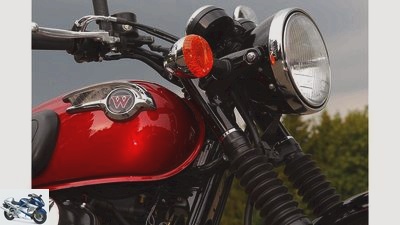
Bilski
62/71
The Kawasaki clearly exudes the classic charm.
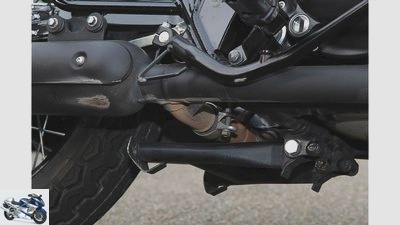
Bilski
63/71
Light and shadow: the main stand is useful for maintaining the chain, and sparks emit sparks at high speeds.

Bilski
64/71
The Kawa pulled almost coarse-treaded Dunlop Roadmaster TT 100 onto its spoked wheels.
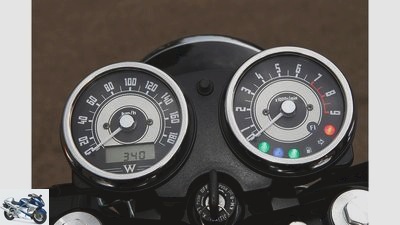
Bilski
65/71
Classic: straightforward round instruments in a chrome ring. With modern digits and small LCD information in the speedometer.
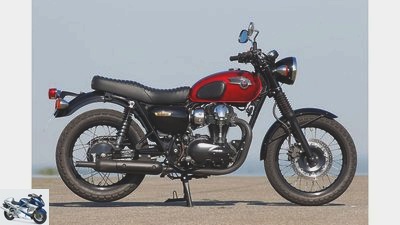
Bilski
66/71
The fork with the beautiful bellows is rather soft.

Bilski
67/71
Even if such a neo-classic doesn’t necessarily appeal to novice drivers: Kawasaki grants new drivers a 773 euro discount, one euro per cm³.
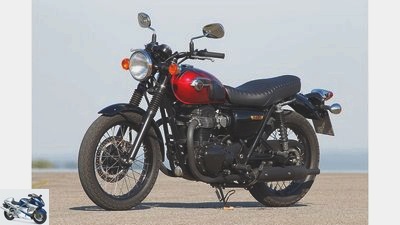
Bilski
68/71
Stylish: bellows accordion on the fork, mudguard struts and graceful, slim two-cylinder.
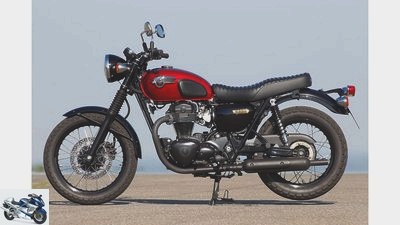
Bilski
69/71
With the Kawasaki W 800 SE you can clearly feel the pulse of the parallel twin.
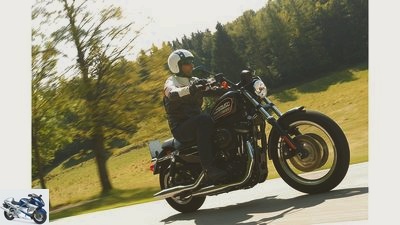
Bilski
70/71
Even the little Harleys are icons of mechanical engineering.
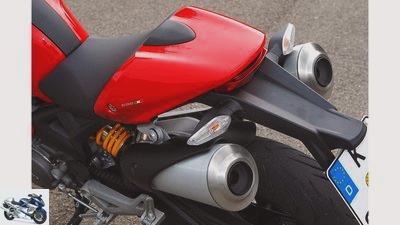
Bilski
71/71
Aesthetic forms. Elevated exhausts are only partially modern;
The shock absorber is directly hinged on the left.
Honda CB 500 F, Ducati Monster, Suzuki Gladius, Harley 883 R, Kawasaki W 800, BMW F 700 GS, Honda NC 700 X
Seven 48 hp twins in a comparison test
The new entry-level and advancement class now offers a whopping 48 hp and a whole range of very attractive machines. This also applies if you limit yourself to the two-cylinder models presented here. If you don’t get up now, it’s your own fault!
4th8 hp twins in a comparison test
The other day my family doctor spoke to me, a tall, experienced man who is not upset: “Imagine,” he said excitedly, “I’ll get my motorcycle license!” And then he’ll fulfill a dream: “I’ll buy me a Harley. ”One with a maximum of 48 hp. Because he wants to get the new entry-level driving license for class A2. This means that he belongs to the targeted target group, along with 18 to 23-year-old novice drivers: He got his driver’s license before April 1980 – so he doesn’t have to study theory for A2 and take no compulsory driving lessons. A weighty argument for a seasoned, busy late fifties. Good luck with the practical exam, Doctor!
Buy complete article
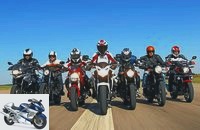
Honda CB 500 F, Ducati Monster, Suzuki Gladius, Harley 883 R, Kawasaki W 800, BMW F 700 GS, Honda NC 700 X
Seven 48 hp twins in a comparison test
Subscribe to MOTORRAD videos on Youtube
Entry-level machines have never been more tempting
You have to follow your dream. But other mothers, i.e. motorcycle manufacturers, also have beautiful daughters. With the increase in the tier driving license from 34 to 48 HP, a plus of a whopping 40 percent, tons of attractive new models have appeared. Entry-level machines have never been more tempting than today. There is an enormous range of affordable models, from thundering single cylinders to the twins represented here and beguiling three-cylinders to whispering four-cylinders à la Yamaha XJ6. Even among the two-cylinder engines, the ideal engine for this performance class, there is a large selection. On machines that make it easy for men and women.
Three novice drivers as co-testers
For this reason, MOTORRAD took three different novice drivers with them for this comparison test. They got real characters to ride on two wheels. Our septet doesn’t look like Fahr-und-Spar. But it stands for a lot of driving pleasure. That’s why the two sportier representatives, Ducati Monster 696 and Suzuki Gladius, also enjoy the right of way. Curtain up, Italy versus Japan!
Suzuki Gladius and Ducati Monster 696
Bilski
The sporty: Suzuki Gladius, Ducati Monster 696.
Ducati Monster 696 and Suzuki Gladius inspire splendid V2 engines with 90-degree cylinder angles. The Monster 696 is characterized by fine workmanship. Even the cheapest Ducati spoils with fine details. 20 years after the first Monster M 900, these include the massive aluminum swing arm and the fat upside-down fork, the only one of this type here in the test field. At first glance, the smallest monster cannot be distinguished from its larger siblings 796 and 1100. At the same time, however, it is extremely graceful with a low seat height of 78 centimeters. Even those with short legs can reach the earth that is saving them.
Small, compact, full of character. Above all, the wiry Ducati is the lightest offer in the test field, it weighs only 185 kilograms. In contrast, the not too heavy 206 kilos of the rounded styled Suzuki Gladius seem almost massive. It has water cooling instead of air cooling and a heavier steel box swing arm. The tubular space frame painted in fire red is made of steel. The Monster combines this with a bolted rear made of lightweight aluminum. While the gladius wears painted plastic covers over her frame as thick makeup.
Bilski
The Suzuki Gladius: Rounded shapes, black painted damper, steel swing arm and simple fork.
On the Ducati, the entire exhaust system is made of stainless steel. The front bend looks like a scarf elegantly thrown over the shoulder. With the Suzuki, stainless steel manifolds lead into a clumsy black painted muffler. The monster shows two mufflers placed halfway up. They sound crispy, trumpet-bassy beat. Vital V2 staccato is also mastered by the gladius. Well muffled, not intrusive, dull enough. Right from the start, the 650 V2 hangs wonderfully directly, sensitively on the gas. Double throttle valves improve filling as well as responsiveness.
The silky, cultivated Suzuki engine gets down to business in a lively manner, vibrating the least of all seven drive units. A thrilling country road engine! Up to 5000 tours you hardly notice that this is the 48-hp throttle version. No wonder, the throttling using another control unit fits perfectly. Costs 160 euros plus ten minutes of working time. Pistons with a smaller diameter and longer stroke work in the highly elastic Vau engine than in the Monster. Brings power at low speed.
In addition, there is a shorter gear ratio: At 100 km / h, the Gladius turns 4900 / min, the Monster only 4600 / min. The Suzuki has the highest performance of all seven machines on the rear wheel at the same speed! With the best draft in sixth gear. It looks like the Gladius, not the Monster, has more displacement. The Duc needs speed. Little goes around below. For full thrust and good concentricity, you have to shift down more often. Ideally, there are 4000 tours in the upper aisles.
Bilski
The Ducati Monster 696 is characterized by fine workmanship. Despite its low price, it spoils you with elegant details.
The sixth does it from Tempo 75. Then the V2 shines with a fiery, great punch, takes on the gas cleanly, accelerates the fastest in the entire septet. The short-stroke throttle of the Italo-V-Zwos can be irritating. A clumsy stop on the throttle valve limits the travel on the throttle cable to a few centimeters. And officially the power is only 44 hp. For no apparent reason, Ducati, like Harley-Davidson, does not exhaust the legally permitted 48-hp limit. Is self-circumcision considered a sin in Catholic Italy? When starting off, the monster’s poorly metered anti-hopping clutch is annoying. In contrast to the Gladius, it is not operated mechanically by a cable, but hydraulically by oil. And moves in easily, but with a lot of “plucking”.
With its better chassis, the Ducati turns the tables. No other machine here scurries so playfully and lightly through the curve thicket. Technically, the short wheelbase and caster meet the steepest steering head angle. It feels as if you experience the best handiness and feedback including the greatest freedom of inclination. Lustful. Steering commands are easy to do, direct and immediate. The sensual 696 feels stiff in the good sense despite all its maneuverability. She always remains neutral, never gets nervous and thus conveys a lot of trust.
Especially since the baby monster is in balance; The fork and shock absorber work synchronously and homogeneously. Both are more sporty and firm, but also comfortable enough. On the Monster, it feels as if the downward cranked handlebars directly embrace the front axle. The sporty, forward-facing sitting position is strenuous in the long run. Small people in particular have to reach far to the handlebars. In addition, there is the acute knee angle due to the high and far back footrests. The massive brackets for the passenger footrests lead to cramps in tall riders with boots like these.
Bilski
For long journeys, the thigh support of the Suzuki’s seat is a bit small, the last bit of contact with the motorcycle is missing.
You sit compactly on the Gladius. Your handlebars are approaching close to your chest. For long journeys, the seat’s thigh support is a bit small, and there is no last bit of contact with the motorcycle. In addition, the nipples under the footrests touch down earlier when you are sporty. With such, the underdamped strut reaches its limits. It speaks woody, starts pumping on heels or over bumps, where Monster (and BMW) remain completely unimpressed. So there is always some movement in the Suzuki chassis. He lacks reserves, especially when riding with a pillion.
The 650 spoils you with a full 214 kilograms of payload. Only the BMW saddles even more. The Duc is allowed to take 205 kilos of ballast. Passengers ride the Suzuki more comfortably. The hard, higher Ducati rear seat offers little contact with the vehicle in front, but a good overview. The monster’s brake is great in terms of its effectiveness and controllability. Against the four-piston stoppers of the monsters, the double-piston floating calipers of the Gladius look old. Good: ABS as standard here and there. Better, more sensitive control with the Ducati.
Gladius in personal ranking in second place
The monsters roll on great sports touring tires, Pirelli Angel ST. Unlike the Dunlop Qualifier of the Gladius, which offer little grip and feel for what is happening in the rain. Suzuki’s 6000 maintenance intervals seem out of date. The Ducati comes twice as far between service appointments. A full 12,000 kilometers, like both Hondas. In addition, the Monster is best processed together with the Harley. However, also 9,000 euros expensive. Unfortunately, Ducati does not grant discounts for motorcycle beginners.
But Suzuki, especially for the Gladius in general. At the official promotional price of 6640 instead of the regular 7440 euros, the 650 is a great offer, including a two-year mobility guarantee. Our three novice drivers all lift the Gladius to second place in the personal ranking. Even if she has to rank just behind the monster in the points evaluation.
Data and measured values
| Suzuki Gladius ABS | Ducati Monster 696 | |
| engine | ||
| design type | Two-cylinder four-stroke- 90 degree V engine |
Two-cylinder four-stroke- 90 degree V engine |
| injection | Ø 39 mm | Ø 45 mm |
| coupling | Multi-disc oil bath clutch | Multi-disc oil bath clutch (Anti-hopping) |
| Bore x stroke | 81.0 x 62.6 mm | 88.0 x 57.2 mm |
| Displacement | 645 cc | 696 cc |
| compression | 11.5: 1 | 10.6: 1 |
| power | 35.0 kW (48 hp) at 7600 rpm | 32.0 kW (48 hp) at 9000 rpm |
| Torque | 56 Nm at 4000 rpm | 48 Nm at 4000 rpm |
| landing gear | ||
| frame | Steel tubular frame | Composite frame made of steel with screwed cast aluminum parts |
| fork | Telescopic fork, Ø 41 mm | Upside-down fork, Ø 43 mm |
| Brakes front / rear | Ø 290/240 mm | Ø 320/245 mm |
| Assistance systems | SECTION | SECTION |
| bikes | 3.50 x 17; 5.00 x 17 | 3.50 x 17; 4.50 x 17 |
| tires | 120/70 ZR 17; 160/60 ZR 17 | 120/60 ZR 17; 160/60 ZR 17 |
| Tires | Dunlop Sportmax Qualifier, “J” | Pirelli Angel ST |
| measurements and weight | ||
| wheelbase | 1445 mm | 1452 mm |
| Steering head angle | 65.0 degrees | 66.0 degrees |
| trailing | 104 mm | 96 mm |
| Front / rear suspension travel | 125/130 mm | 120/148 mm |
| Seat height * | 790 mm | 780 mm |
| Weight with a full tank | 206 kg | 185 kg |
| Payload * | 214 kg | 205 kg |
| Tank capacity / reserve | 14.5 liters | 15.0 / 3.0 liters |
| Service intervals | 6000 km | 12,000 km |
| price | 7290 euros | 8790 euros |
| Price test motorcycle | 6490 Euro (Best Price) | 8790 euros |
| Additional costs | 150 euros | 305 euros |
| Power reduction 48 HP | 160 euros plus 10 minutes of working time | No extra charge for new purchases |
| throttling | Engine control unit | Throttle valve stop |
| Driving license campaign 48 PS | no | no |
| MOTORCYCLE readings | ||
| Top speed ** | 165 (165 *) km / h | 170 (168 *) km / h |
| acceleration | ||
| 0-100 km / h | 6.1 sec | 5.6 sec |
| 0-140 km / h | 14.4 sec | 12.0 sec |
| Draft | ||
| 60-100 km / h | 5.1 sec | 5.6 sec |
| 100-140 km / h | 7.7 sec | 8.4 sec |
| Consumption highway | 3.9 liters | 4.1 liters |
| Reach country road | 372 km | |
366 km
* MOTORCYCLE measurements; ** Manufacturer information
Harley-Davidson 883 Roadster and Kawasaki W 800 SE
Bilski
The classic ones: Harley-Davidson 883 Roadster and Kawasaki W 800 SE.
The Harley-Davidson Sportster 883 Roadster embodies a class of its own: The American Way of Ride! Of course, the company also offers 1200 Sportsters or even Big Twins with 48 hp. But maybe the cheapest Harley for beginners will cut a better figure? The 883 is available for less than 9,000 euros. In this comparison, it meets Kawasaki’s classic W 800. It embodies the most English of all Japanese motorcycles, a return to the Roaring Sixties. Therefore, the Kawa instead of a Triumph Bonneville competes here – which would also come from Asia, from the Triumph factory in Thailand.
Especially since the Kawasaki is a long stroke made of real shot and grain: As with the Harley, the stroke is larger than the piston diameter. Even if the 883 gets its 110 more cubic meters out of even more stroke. What you can see in their high cylinders, which are traditionally spread by 45 degrees. It doesn’t have to be a mistake to be air-cooled with real cooling fins. In the case of the Kawasaki, it is garnished with an exclusive vertical shaft on the right-hand side of the engine: the overhead camshaft drives a full four valves per cylinder. In contrast to the blissful W 650, kicking is a thing of the past with the 800, it starts purely electrically. Too bad. Tribute to injection and G-Kat. The left and right routed exhausts are in the “Special Edition" whitewashed black. Chrome-plated silencers of the standard W fit better into the concept. And the Kawa sounds a bit thin.
Bilski
The Harley-Davidson Sportster 883 Roadster embodies a class of its own: The American Way of Ride!
The US roadster only has two valves each, driven by style-defining bumpers and four camshafts below. Even the smallest Harley V2 is an icon of mechanical engineering. A Harley explains itself, is a myth and a statement on two wheels. Pure and puristic. The V2 starts to work with a rumble, pouting inimitably, but discreetly from the two exhaust pipes on the right. They just pretend they’re apart. In fact, the fat two-cylinder urgently needs the interference tube hidden here. Sounds a bit like VW Beetle, the US twin.
Uff, not that easy at all to heave the 266 kilo cruiser into a vertical position. Despite the 75 centimeter deep seat, eight centimeters less than on the BMW. Not because of “Baby Sportster”: The 883 also embodies American heavy metal. Stable, solid, a real iron. The US paint looks thicker, the chrome shinier. Not only are the mudguards (noun est omen) heavily metallic, but even the indicator housings. Looks built to last. The material value probably justifies the almost 9,000 euros. Or Harleys are known to be good value retention.
Bilski
Stylish: bellows accordion on the fork, mudguard struts and graceful, slim two-cylinder.
Kalonk. The first course is sitting. All subsequent switching operations are also loudly communicated to the environment. The V2 elastic band starts moving gently and without jerks. Load change reactions with gas-to-gas-to are completely alien to him. Great: the septet’s only toothed belt. Clean, low-maintenance and low-reaction. Although the Roadster does not have a rev counter, you can feel intuitively how the V2 wants to be moved. Low speed. The ultra-long stroke pushes the fatest torque up to almost 5000 tours. Even if the BMW piles up even more Newton meters for a short time at almost 3000 rpm, namely 67.8.
You can clearly feel the pulse of the parallel twin on the Kawa. How it bubbles up nicely evenly and powerfully through the speed range. Already spoiled with great concentricity and a lot of power on 2000 tours. In terms of performance on the rear wheel, the Kawa is ahead of the Harley. Tempo 100 is 3750 tours in the W in the final fifth gear, the Sportster turns 300 rpm less. And accelerates very moderately. Doesn’t play a role for relaxed gliding.
Especially since it officially leaves the US bike with 45 instead of 53 PS; throttled via perforated diaphragms in the intake tract and software. In contrast, the W 800 was trimmed to the new 48 hp class from the start. And so the 217 kilogram Kawa has no trouble pulling away. You can’t argue away 60 kilos. The pulsing of these motors also does not. Low frequency, always noticeable, a calming resting heart rate. It really stomps, the Harley, lets you soak up the feeling of freedom in a relaxed manner, receive the wind with open arms, as long as the pace remains leisurely. The motto: more experience per kilometer.
Bilski
Even the little Harleys are icons of mechanical engineering.
The US seating position is unique. Behind the Buffelhorn handlebars you feel like the King of the Road, meaning you are seeing more of the landscape. But only X-legers get a knee grip on the Harley with the narrow, small 12.5-liter tank. The air filter is in the way on the right. Objectively not good, subjectively there is something, the imperfect, unpolished. Hard but warm: the American struts. The Kawa is easier to get along with, its slim, low handlebars are easy to handle. The thick, 80 centimeter high bench is comfortably upholstered. Park your knees up on rubber cushions on the 14 liter tank. Sitting posture from the 50s to 70s.
The driving behavior of the 800 series matches this. Your completely underdamped suspension struts rock on bumps. The fork with the beautiful bellows is also rather soft. The Japanese has pulled almost coarse-treaded Dunlop Roadmaster TT 100 onto her spoke wheels. Tribute to the first tires that made the Isle of Man an average of 100 miles per hour. Which roughly reflects the top speed of the Kawasaki, 168 km / h. The 800 commutes a little less on the autobahn, by the way, with an adequately accommodated pillion passenger. But this is certainly not your preferred area.
Despite the narrowest of the seven rear tires, the Kawasaki defends itself somewhat against folding down and only turns in with gentle emphasis. Of which the Harley needs a lot. When tilted, the W 800 understeers a little and turns further on its own. Until it sparks, between footrests and asphalt – a touch later than on the Harley. Which can irritate not only beginners. Even so, the slower US iron is a tad more stable. On the other hand, the passenger feels quite at the mercy of the small, hard seat-bun. The Michelins of the Harley are slippery when wet. So be careful, there is no ABS on board. Harley won’t bring it until 2014, after all.
Bilski
With the Kawasaki you can reach top speeds of 168 km / h.
The 883 with three disks already brakes better than the Kawa today. Their individual discs require a lot of hand strength for little effect. And the rear drum isn’t much of a support. Braking less is not possible. So be it. When the two air-cooled drumsticks crackle for hours after the ride – the thirsty Harley has to drink early – you feel reconciled with everything. Nearly. Because the Kawa should be better processed. This simple luster terminal appearance and the exposed cables do not fit into the picture.
Even if both neo-classics don’t necessarily appeal to novice drivers: Kawasaki grants new drivers a 773 euro discount, one euro per cm3. Harleys sell that way too. With longer maintenance intervals (8000 instead of 6000 kilometers) and a one-year mobility guarantee.
Data and measured values
| Harley-Davodson Sportster 883 Roadster |
Kawasaki W 800 SE |
|
| engine |
||
| design type | Two-cylinder four-stroke- 45 degree V engine |
Two-cylinder four-stroke- In-line engine |
| injection | Ø 45 mm | Ø 34 mm |
| coupling | Multi-disc oil bath clutch | Multi-disc oil bath clutch |
| Bore x stroke | 76.2 x 96.8 mm | 77.0 x 83.0 mm |
| Displacement | 883 cc | 773 cc |
| compression | 9.0: 1 | 8.4: 1 |
| power | 33.0 kW (45 PS) at 5750 rpm | 35.0 kW (48 hp) at 6500 rpm |
| Torque | 68 Nm at 3250 rpm | 60 Nm at 2500 rpm |
| landing gear | ||
| frame | Double loop frame made of steel | Double loop frame made of steel |
| fork | Telescopic fork, Ø 39 mm | Telescopic fork, Ø 39 mm |
| Brakes front / rear | Ø 292/292 mm | Ø 300/160 mm |
| Assistance systems | – | – |
| bikes | 2.50 x 19; 3.0 x 16 | 2.15 x 19; 2.75 x 18 |
| tires | 100 / 90B 19; 150 / 80B 16 | 100/90 19; 130/80 18 |
| Tires | Michelin Scorcher “31” | Dunlop Roadmaster TT 100 GP |
| measurements and weight |
||
| wheelbase | 1520 mm | 1465 mm |
| Steering head angle | 60.3 degrees | 63.0 degrees |
| trailing | 112 mm | 108 mm |
| Front / rear suspension travel | 141/104 mm | 130/106 mm |
| Seat height * | 750 mm | 800 mm |
| Weight with a full tank | 266 kg | 217 kg |
| Payload * | 188 kg | 183 kg |
| Tank capacity / reserve | 12.5 / 3.8 liters | 14.0 liters |
| Service intervals | 8000 km | 6000 km |
| price | 8495 euros | 8590 euros |
| Price test motorcycle | 8495 euros | 8590 euros |
| Additional costs | 380 euros | 170 euros |
| Power reduction 48 HP | 35 euros plus 1.5–2 hours of working time | series |
| throttling | Reducing diaphragm | series |
| Driving license campaign 48 PS | no | 773 euros (1 euro = 1 cm³) |
| MOTORCYCLE readings |
||
| Top speed ** | 155 (155 *) km / h | 170 (168 *) km / h |
| acceleration | ||
| 0-100 km / h | 8.0 sec | 6.1 sec |
| 0-140 km / h | 19.1 sec | 14.0 sec |
| Draft | ||
| 60-100 km / h | 7.5 sec | 6.6 sec |
| 100-140 km / h | 11.0 sec | 9.8 sec |
| Consumption highway | 5.4 liters | 4.1 liters |
| Reach country road | 231 km | 341 km |
* MOTORCYCLE measurements; ** Manufacturer information
Honda NC 700 X and BMW F 700 GS
Bilski
The Honda NC 700 X and the BMW F 700 GS are suitable for everyday use.
The next pairing is the BMW F 700 GS and the Honda NC 700 X. Both are large, grown-up and particularly powerful models. Which are further apart in cubic capacity than you initially think. The deeply stacked BMW has a full 798 cm3, so it is a real 800. In contrast, the NC 700 is content with 670 cubic meters. Both have in-line engines, just configured differently. BMW has opted for a counter-rotor with a balancer shaft. Honda relies on the NC series (there is also the “S”, which is around 500 euros cheaper), on 270 degrees of crank pin offset. This simply mimics a 90-degree V2 due to the uneven firing order.
Both engines are behind steel tube cages. Moderately long suspension travel on road enduros stands for “adventure light”. The BMW offers 17 centimeters each at the front and rear, and the NC 700 X 15.5 and 15 centimeters. This should be enough to smooth out furrowed tar into gourmet asphalt. First of all, you have to board the largest and tallest machines in this field. For short candidates, 83 centimeters seat height for the GS and 82 for the NC represent a real hurdle. Well, in addition to the comfort bench installed here, BMW also offers higher and lower benches. Honda has the NC 700 S as an option. With the same wheel sizes, it is three centimeters lower than sister X both in seat height and suspension travel.
Blacksmith
The Honda NC 700 X is a full dresser: Touring windshield, crash bars and additional lamps cost extra like the suitcase.
The test Honda has plenty of accessories: high windshield, crash bars with additional lights, heated grips and the narrow luggage set. Which increases the basic price of 5990 euros by almost 1900 euros. The BMW also carries extras for around 1700 euros at a steep 8750 euros base price. Consists of traction control, tire pressure monitoring, electronically adjustable damping on the shock absorber, main stand, heated grips, on-board computer, said comfort seat and Vario cases. Equipped in this way, the GS comes to 218, the Honda even to a mighty 226 kilograms. This initially demands respect from rising beginners. Don’t worry, it will be fine.
The F 700 GS wakes up highly motivated, hangs fine, but never rough on the gas. The engine pushes lively and smoothly from the lowest speeds. By putting on the throttle, BMW throttles the twin from 75 to 48 hp for free. From the 5000 mark, the vigor slackens a little. Not bad, by then there is already enough power. The GS engine runs rougher than the Honda Twin, especially in the second half of the engine speed and when taking off the gas.
Bilski
The deeply stacked BMW F 700 GS has a full 798 cm³, so it’s a real 800.
You can tell that the NC 700 is a Langhuber, a “cold blood”. Comes powerfully from below. Oops, the engine keeps wriggling with the steeply inclined cylinder bank in the rev limiter. He already pinches at 6500 tours. Sometimes in the middle of overtaking. The peculiar transmission joins the car-like narrow speed range. The lower gears of the NC are extremely tightly spaced, but the sixth gear is designed as an extremely long overdrive to reduce the speed. It only works properly at speeds of 70 or more. Tempo 100 means slow speed 3400. Fast propulsion requires a lot of switching work. But it is economical, only a good three liters per 100 kilometers when driven in compliance with the German Road Traffic Act. The BMW needs half a liter more.
The fork and shock absorber of the F 700 GS work enthusiastically and delicately scan the asphalt relief. Even if it’s rough and bumpy. Great. BMW’s weakest two-cylinder is completely committed to the GS tradition. Balanced and homogeneous. The most comfortable suspension strut in this field of seven is the only one with a practical handwheel for adjusting the load. Its damping can be controlled electronically from the handlebar for an additional charge. Tighter or more comfortable, just as you like it. The neutral GS chassis accepts course corrections at any time. Even in deep slopes. The wide handlebar makes it easy to use as a large lever arm. The narrow 140 mm rear tire even more. Despite the long wheelbase. On Japanese Bridgestone tires, the German draws predictably, precisely in circles.
Bilski
The engine of the Honda pushes lively and smoothly from the lowest revs.
But the Japanese gives the feeling of being invulnerable on German Metzeler Roadtec tires. You feel good, even if the notches give off sparks earlier than with the BMW. The feedback from the NC front wheel should be better. The Honda can be easily bent. Okay, on hard, quickly following heels, the fork chucks a bit, doesn’t quite keep up with processing. Never mind. Because both adventure bikes convey absolute security. What the NC touring windshield contributes to. It shields the torso and shoulders of medium-sized drivers. However, it causes loud wind noise.
You don’t even want to get down from the well-contoured, padded comfort seat of the GS. The Honda seat, on the other hand, should be a tad softer in the long run. Big people have the Honda under control and sit passably. Passengers travel upright and lofty here as there. Just like the drivers. The NC pampers young and old with its exclusive “trunk”, the helmet compartment between the seat and the steering head. So easy, so practical. Open the flap, put your luggage in. How to pick up drivers! NC and GS bunker fuel in the rear. The filler neck of the Honda is under the pillion seat, that of the BMW is more practical on the right side. A warm welcome to summer rain: heated grips. They feel like a warm shower.
Bilski
BMW even gives newcomers a discount of 1,000 euros.
The brakes work in a practical manner. The Honda couples its single disc at the front with a combination brake system: when you step on the brake pedal, one of the three pistons at the front brakes too. Drivers welcome. At BMW, the more stable double pane at the front was the most important model maintenance measure from the so-called F 650 GS to the current 700. Good thing, the GS now brakes heavily. Without setting up in an inclined position.
Alternatively, Honda offers the DCT dual clutch transmission for the NC models. It weighs ten kilograms and costs 1000 euros extra. With unmatched shifting comfort, it could ensnare motorists who are used to automobiles. Simply accelerate without using the clutch, and DCT will do the rest. But it can also be switched manually, using Triptronic. Or rather, it could be done. Because with the double clutch, the output is 52 hp – not A2-compliant.
Honda no longer grants discounts for new drivers. The NC 700 models are selling like sliced bread anyway, and together they rank second among new sales. BMW grants beginners a discount of 1000 euros, so that the test copy of the F 700 GS would come back just below the 10,000 euros mark. She’s already group winner.
Data and measured values
| Honda NC 700 X |
BMW F 700 GS |
|
| engine |
||
| design type | Two-cylinder four-stroke- In-line engine |
Two-cylinder four-stroke- In-line engine |
| injection | Ø 36 mm | Ø 46 mm |
| coupling | Multi-disc oil bath clutch | Multi-disc oil bath clutch |
| Bore x stroke | 73.0 x 80.0 mm | 82.0 x 75.6 mm |
| Displacement | 670 cc | 798 cc |
| compression | 10.7: 1 | 12.0: 1 |
| power | 35.0 kW (48 hp) at 6250 rpm | 35.0 kW (48 hp) at 7000 rpm |
| Torque | 60 Nm at 4750 rpm | 60 Nm at 5000 rpm |
| landing gear | ||
| frame | Steel tubular frame | Steel tubular frame |
| fork | Telescopic fork, Ø 41 mm | Telescopic fork, Ø 41 mm |
| Brakes front / rear | Ø 320/240 mm | Ø 300/265 mm |
| Assistance systems | Compound brake, ABS | SECTION |
| bikes | 3.5 x 17; 4.5 x 17 | 2.50 x 19; 3.50 x 17 |
| tires | 120/70 ZR 17; 160/60 ZR 17 | 110/80 19; 140/80 17 |
| Tires | Metzeler Roadtec Z8 Interact, front “E” |
Bridgestone, front BW 501 “G”, rear BW 502 “G” |
| measurements and weight |
||
| wheelbase | 1540 mm | 1562 mm |
| Steering head angle | 63.0 degrees | 64.0 degrees |
| trailing | 110 mm | 95 mm |
| Front / rear suspension travel | 154/150 mm | 170/170 mm |
| Seat height * | 825 mm | 830 mm |
| Weight with a full tank | 226 kg | 218 kg |
| Payload * | 201 kg | 218 kg |
| Tank capacity / reserve | 14.1 liters | 16.0 / 4.0 liters |
| Service intervals | 12,000 km | 10000 km |
| price | 5990 euros | 8750 euros |
| Price test motorcycle | 7872 euros | 10515 euros |
| Additional costs | 265 euros | 390 euros |
| Power reduction 48 HP | series | No extra charge for new purchases |
| throttling | series | Throttle valve stop |
| Driving license campaign 48 PS | 10% (expired) | 1000 Euro |
| MOTORCYCLE readings |
||
| Top speed ** | 160 (163 *) km / h | 165 (170 *) km / h |
| acceleration | ||
| 0-100 km / h | 5.5 sec | 6.0 sec |
| 0-140 km / h | 12.3 sec | 13.2 sec |
| Draft | ||
| 60-100 km / h | 7.7 sec | 5.4 sec |
| 100-140 km / h | 14.5 sec | 8.3 sec |
| Consumption highway | 3.2 liters | 3.8 liters |
| Reach country road | 441 km | 421 km |
* MOTORCYCLE measurements; ** Manufacturer information
Honda CB 500 F.
Bilski
The Honda CB 500 F is one of the agile 48er bikes.
The Honda CB 500 F drives 200 cc less than the NC 700. Yes, two Hondas are allowed to test, because this manufacturer is particularly equipping the new 48-hp class with specially tailored models. The smallest of the seven samurai, our brave A2-Twins, is bold. The displacement Benjamin develops almost 100 hp per liter. With a square design, bore and stroke are practically identical, he really throws himself into it right from the start. Comes up from the lower rev range in a flexible and jolt-free manner, turns unexcitedly up to the 8500 mark, although hardly any power is added from 7500 tours. Narrow-chested? No way!
With a switching speed of 3000 or 4000 you can swim with you in traffic. When accelerating, the CB bravely keeps up with the large NC 700, when pulling through in sixth gear it even drives away from it. The 500 series is also satisfied with just over three liters of petrol per 100 kilometers. The mini-twin is just great, has plenty of reserves. Honda has completely redeveloped it, not just using the good engine of the CB 500 from the 90s. The precise and smooth clicking gear fits perfectly with the lively drive. Ideally graded, it always has the right gradation ready without annoying you with too high speeds. Tempo 100 is a moderate 5100 tours – the 600 four-cylinder engine turns higher. In the engine chapter of the 1000-point rating, the CB 500 F ranks just one point behind the famous V2 of the Suzuki Gladius.
Bilski
The mini-twin is just great, has plenty of reserves. Honda has completely redeveloped it, not just using the good engine of the CB 500 from the 90s.
Any questions? In its own way, the highly agile 500 series conveys a lot of driving pleasure. So agile, so light, so easy. Extremely handy. Thanks to the shortest wheelbase, a lighter weight of 193 kilograms and compact dimensions. The Honda built in Thailand drives well, really well. And definitely emotional, because bold and cheeky. Everything fits right from the start. You sit perfectly integrated in the middle of the motorcycle. Even tall novice drivers feel most comfortable on the 500.
It sticks loosely to the rear wheel of much larger machines. The displacement flea circles the corners most precisely on Metzeler tires. The driving behavior of the little heartbreaker is simply awesome. Because even the simply knitted spring elements are convincing. Together with the twice as expensive BMW, the CB 500 F wins the chassis classification! Impressive. Together, two brake discs front and rear have the flea well under control. All components are highly effective and come together as a system to form a whole. The little one can even ride a pillion; the passenger sits neatly and has good handles.
Practical: long maintenance intervals of 12,000 and the highest ground clearance (even before the pseudo enduros!) – good for climbing curbs. At the cheapest price of less than 6,000 euros, the 500 is a damn nimble and well thought-out motorcycle. The good news is: The five hundred, this once glorious displacement class, are back with a bang. For the good score in combination with the low price, there is a dream score of 1.0 in the price-performance ratio, and subjectively, the little Honda is also very popular with novice drivers.
Data and measured values
| Honda CB 500 F |
||
| engine |
||
| design type | Two-cylinder four-stroke in-line engine | |
| injection | Ø 34 mm | |
| coupling | Multi-disc oil bath clutch | |
| Bore x stroke | 67.0 x 66.8 mm | |
| Displacement | 471 cc | |
| compression | 10.7: 1 | |
| power | 35.0 kW (48 hp) at 8500 rpm | |
| Torque | 43 Nm at 8500 rpm | |
| landing gear | ||
| frame | Bridge frame made of steel | |
| fork | Telescopic fork, Ø 41 mm | |
| Brakes front / rear | Ø 320/240 mm | |
| Assistance systems | SECTION | |
| bikes | 3.5 x 17; 4.5 x 17 | |
| tires | 120/70 ZR 17; 160/60 ZR 17 | |
| Tires | Metzeler Roadtec Z8 Interact, front “E” |
|
| measurements and weight |
||
| wheelbase | 1410 mm | |
| Steering head angle | 64.5 degrees | |
| trailing | 102 mm | |
| Front / rear suspension travel | 108/119 mm | |
| Seat height * | 790 mm | |
| Weight with a full tank | 193 kg | |
| Payload * | 181 kg | |
| Tank capacity / reserve | 15.7 liters | |
| Service intervals | 12,000 km | |
| price | 5490 euros | |
| Price test motorcycle | 5490 euros | |
| Additional costs | 265 euros | |
| Power reduction 48 HP | series | |
| throttling | series | |
| Driving license campaign 48 PS | 10% (expired) | |
| MOTORCYCLE readings |
||
| Top speed ** | 175 (172 *) km / h | |
| acceleration | ||
| 0-100 km / h | 5.6 sec | |
| 0-140 km / h | 12.4 sec | |
| Draft | ||
| 60-100 km / h | 6.4 sec | |
| 100-140 km / h | 7.8 sec | |
| Consumption highway | 3.2 liters | |
| Reach country road | 491 km | |
* MOTORCYCLE measurements; ** Manufacturer information
Test results and scoring
Bilski
Full broadside, sorry: bandwidth. Wide range of various twins.
All seven machines receive a school leaving certificate. There is also a lot on offer in the entry-level class. But what does a beginner mean here? They even make old hands happy. If you want more: BMW, Ducati, Harley and Suzuki can be de-throttled to full power after two years of the A2.
MOTORCYCLE test results
1st place: BMW F 700 GS
Yes, it is the best bike in this test. Balanced, versatile, with well thought-out details. No, the smallest two-cylinder GS is not the best offer for beginners. She’s already too grown up for them. And when fully equipped, the 700, which is an 800, costs over 10,000 euros.
2nd place: Honda CB 500 F
The cheapest, smallest motorcycle in a large comparison comes that far up? Exactly because it is so handy and lively, blessed with a lively, economical engine. The CB instills the most trust in beginners and inspires old hands. Fine!
3rd place: Honda NC 700 X
A good-natured, extremely practical motorcycle. The success of the two NC 700 models X and S has good reasons. Getting used to the narrow rev range and the long sixth gear, which forces you to downshift. The more compact S is better suited for beginners.
4th place: Ducati Monster 696
Agile, sporty and sensual: the smallest monster is a big one, fulfills the Ducati promise of high driving pleasure without being annoying with uncompromisingness. Your fine V2, however, is clumsily throttled. And the seating position is not for everyone.
5th place: Suzuki Gladius
Silky, supple, inspiring: Suzuki’s 650 V2 is one of the best motorcycle engines even in the 48 hp version, thanks to the perfect type of throttling. A top offer as the best price bike for 6490 euros. Even if the chassis doesn’t keep up with the super drive.
6th place: Kawasaki W 800
Special Edition A nice youngtimer ex works. That said the most important thing. The long-stroke motor with vertical shaft has character. This is offset by the unstable chassis, the worst brakes of the septet and the mediocre workmanship.
7th place: Harley-Davidson Sportster 883 R
Take it or leave it. You want the sparkling US roadster either exactly or not at all. It polarizes, offers very special driving experiences. These include the strange sitting posture and the rubber band motor, which makes little of a lot of displacement.
MOTORCYCLE scoring
engine
| Maximum score |
BMW F 700 GS |
Ducati Monster 696 |
Harley-Davidson Sportster 838 Road. |
Honda CB 500 F |
Honda NC 700 X |
Kawasaki W 800 Special edition |
Suzuki Gladius ABS |
|
| Draft | 40 | 12th | 11 | 5 | 10 | 3 | 8th | 13 |
| acceleration | 40 | 5 | 11 | 1 | 7th | 7th | 5 | 5 |
| Top speed | 30th | 7th | 6th | 4th | 7th | 5 | 6th | 6th |
| Engine characteristics | 30th | 19th | 16 | 15th | 18th | 16 | 18th | 20th |
| Responsiveness | 30th | 13 | 13 | 12th | 13 | 13 | 13 | 13 |
| Load change | 20th | 12th | 10 | 18th | 14th | 13 | 14th | 12th |
| Smoothness | 20th | 11 | 10 | 9 | 13 | 13 | 12th | 15th |
| coupling | 10 | 8th | 6th | 7th | 8th | 8th | 8th | 8th |
| circuit | 20th | 12th | 11 | 9 | 13 | 11 | 11 | 13 |
| Gear ratio | 10 | 8th | 7th | 7th | 9 | 7th | 8th | 8th |
| Start | 10 | 9 | 8th | 6th | 8th | 8th | 8th | 9 |
| total | 250 | 116 | 109 | 93 | 120 | 104 | 111 | 121 |
Head to head race. Just differently than expected: The smallest twins, Honda CB 500 F and Suzuki Gladius, set the best marks. The only 471 cm³ large Honda swings up to the greatest top speed together with the GS and has the best gearbox next to the Gladius. Suzuki’s 650 V2 is a real dream engine, easy-turning, elastic and very sophisticated. And blessed with the best draft. The particularly light Ducati Monster accelerates the fastest. The heavy Harley has to fit perfectly. The Ducati has to be improved by the jerky, poorly metered clutch.
Winner engine: Suzuki
landing gear
| Maximum score |
BMW F 700 GS |
Ducati Monster 696 |
Harley-Davidson Sportster 838 Road. |
Honda CB 500 F |
Honda NC 700 X |
Kawasaki W 800 Special edition |
Suzuki Gladius ABS |
|
| Handiness |
40 | 28 | 33 | 18th | 32 | 28 | 24 | 29 |
| Stability in turns |
40 | 27 | 27 | 19th | 26th | 27 | 20th | 24 |
| Steering behavior |
40 | 25th | 27 | 18th | 30th | 27 | 22nd | 26th |
| feedback |
10 | 6th | 7th | 3 | 6th | 6th | 4th | 5 |
| Inclined position |
20th | 14th | 16 | 8th | 14th | 13 | 9 | 15th |
| Straight-line stability |
20th | 15th | 13 | 12th | 16 | 17th | 11 | 14th |
| Suspension tuning in front |
20th | 12th | 12th | 6th | 12th | 12th | 8th | 11 |
| Chassis set-up at the rear |
20th | 13 | 12th | 5 | 12th | 13 | 8th | 10 |
| Adjustment options undercarriage |
10 | 5 | 2 | 1 | 1 | 1 | 1 | 2 |
| Suspension comfort | 10 | 7th | 5 | 4th | 5 | 6th | 6th | 5 |
| Driving behavior with a passenger | 20th | 13 | 9 | 8th | 11 | 13 | 9 | 10 |
| total | 250 | 165 | 163 | 102 | 165 | 163 | 122 | 151 |
Simply cheeky, the CB 500 F. Sticks to the criterion of playful handiness of the even lighter monsters on the rear wheel. And despite the inexpensive suspension elements in an inclined position, it is almost as stable as the maxi bikes BMW and Honda NC 700 X as well as the sporty, stiff Ducati. The Monster also offers the best feedback and the greatest freedom from lean angles. Harley and W 800 hit the ground early, both have mediocre chassis. The BMW offers the best suspension comfort with a respectful margin on the NC 700 X and Kawa W 800. As the heaviest and largest machines in the Septet, the GS and 700 Honda can easily handle a pillion passenger.
Chassis winner: BMW and Honda CB 500 F
everyday life
| Maximum score |
BMW F 700 GS |
Ducati Monster 696 |
Harley-Davidson Sportster 838 Road. |
Honda CB 500 F |
Honda NC 700 X |
Kawasaki W 800 Special edition |
Suzuki Gladius ABS |
|
| Ergonomics driver | 40 | 33 | 24 | 19th | 29 | 24 | 24 | 26th |
| Ergonomics pillion | 20th | 14th | 7th | 4th | 11 | 9 | 9 | 10 |
| Windbreak | 20th | 4th | 2 | 0 | 10 | 0 | 0 | 0 |
| view | 20th | 12th | 11 | 9 | 13 | 12th | 12th | 13 |
| light | 20th | 14th | 11 | 10 | 12th | 10 | 10 | 11 |
| Furnishing | 30th | 22nd | 6th | 6th | 14th | 9 | 9 | 11 |
| Handling / maintenance | 30th | 18th | 19th | 13 | 13 | 17th | 17th | 17th |
| Luggage storage | 10 | 4th | 1 | 1 | 5 | 2 | 2 | 1 |
| Payload | 10 | 9 | 7th | 5 | 7th | 4th | 4th | 9 |
| Range | 30th | 27 | 23 | 11 | 29 | 20th | 20th | 23 |
| processing | 20th | 12th | 14th | 14th | 12th | 11 | 11 | 12th |
| total | 250 | 169 | 125 | 92 | 155 | 118 | 118 | 133 |
Favorite is clear. Everyday suitability is a BMW domain, and the smallest two-cylinder GS is no exception. With the comfort bench in particular, the “700” offers extremely comfortable ergonomics at the front and rear. There are also upscale features and a full 218 kilograms payload. After all, the Suzuki Gladius saddles 214 kilos, but its chassis is not as unimpressed by ballast as that of the BMW. The Honda NC 700 X offers the best wind protection with its high, but also very loud touring windshield. The equally economical CB 500 F offers even more range than the 700 series Honda.
Winner everyday life: BMW
security
| Maximum score |
BMW F 700 GS |
Ducati Monster 696 |
Harley-Davidson Sportster 838 Road. |
Honda CB 500 F |
Honda NC 700 X |
Kawasaki W 800 Special edition |
Suzuki Gladius ABS |
|
| Braking effect | 40 | 27 | 27 | 21st | 25th | 26th | 18th | 25th |
| Brake metering | 30th | 19th | 21st | 17th | 18th | 21st | 16 | 18th |
| Braking with a passenger / fading | 20th | 14th | 11 | 8th | 12th | 12th | 8th | 10 |
| Righting moment when braking | 10 | 10 | 6th | 5 | 8th | 8th | 10 | 7th |
| ABS function | 20th | 12th | 14th | 0 | 14th | 13 | 0 | 12th |
| Handlebar slapping | 20th | 18th | 17th | 18th | 18th | 18th | 18th | 18th |
| Ground clearance | 10 | 8th | 8th | 5 | 9 | 8th | 7th | 7th |
| total | 150 | 108 | 104 | 78 | 104 | 106 | 77 | 97 |
The squire’s decision. The braking effect of BMW and Monster is the best. It is easier to dose with the Duc. After the GS, the NC 700 is really well presented. At the other end of the spectrum is the Kawasaki W 800: its brakes are toothless and difficult to adjust. ABS is missing from Harley and Kawasaki. The other five wear as standard, with a decent standard quality.
Safety winner: BMW
costs
| Maximum score |
BMW F 700 GS |
Ducati Monster 696 |
Harley-Davidson Sportster 838 Road. |
Honda CB 500 F |
Honda NC 700 X |
Kawasaki W 800 Special edition |
Suzuki Gladius ABS |
|
| guarantee | 30th | 17th | 16 | 16 | 15th | 15th | 15th | 17th |
| Consumption (country road) | 30th | 25th | 24 | 17th | 28 | 28 | 24 | 25th |
| Inspection costs | 20th | 18th | 19th | 12th | 19th | 19th | 12th | 10 |
| Maintenance costs | 20th | 17th | 17th | 17th | 17th | 17th | 17th | 17th |
| total | 100 |
77 | 76 | 62 | 79 | 79 | 68 | 69 |
500 or 700? Both Hondas shine with low fuel consumption and – like the Ducati – long, 12,000 servicing intervals. Suzuki and Kawasaki are expensive to service. Suzuki and BMW offer a two-year mobility guarantee.
Winner costs: Honda and Honda
| Maximum score |
BMW F 700 GS |
Ducati Monster 696 |
Harley-Davidson Sportster 838 Road. |
Honda CB 500 F |
Honda NC 700 X |
Kawasaki W 800 Special edition |
Suzuki Gladius ABS |
|
| Overall rating |
1000 | 635 | 577 | 427 | 611 | 607 | 496 | 571 |
| placement |
1. | 4th. | 7th. | 2. | 3. | 6th. | 5. | |
| Price-performance note | 1.0 | 1.6 | 2.2 | 4.0 | 1.0 | 1.2 | 3.5 | 1.8 |
Price-performance winner: Honda CB 500 F
It couldn’t be better: a really good motorcycle at an attractive price. But the NC 700 X is also a good offer.
Tester opinions
Blacksmith
Beginners either way: first attempts at driving.
The best motorcycle is of little use if it doesn’t suit you personally. This truth is especially true for greenhorns, for whom stopping, turning and driving off are often difficult enough.
Anyone who has 20 or 30 years of driving experience and hundreds of thousands of kilometers under their belt has literally gained a lot of experience and had a lot of time to learn. Intuitively knows how to take peculiarities or even inadequacies of certain motorcycle models. But what if a man or woman is still lacking in routine? What then is in the foreground, what in the background? Quite clearly: trust is the key!
The designers can certainly “build” this into the machines in the form of manageable dimensions, low weight and low seat height. For beginners, ease of use and ease count twice. To test this, MOTORRAD invited people with less driving experience to test driving on country roads, highways and in the pylon course of the test site. Compliments to everyone, thank you very much for the help!
Dina Dervisevic has had a motorcycle license since October 2010. In her private life, she is 1.58 meters tall and drives a Honda CBR 600 F.
David Sehrer has only had the A2 driving license since June 8, 2013. The 20-year-old measures 1.85 meters and drives a Yamaha FZ6 that has been throttled to 48 hp.
At 55 years of age, Thomas Fischer represents the target group for the new A2 driving license. Thomas bought a Moto Guzzi V7 in spring 2013. Here are your subjective statements that do not necessarily correspond to the objective test result.
"Good seating ergonomics is not to be despised"
Hertler
Dina Dervisevic (30) from MOTORRAD online.
Dina Dervisevic (30), MOTORCYCLE online:
The little Honda is my first choice – handy, agile, uncomplicated. In addition, the 500 cubic centimeter engine is a lot of fun! The gladius comes close behind. Your engine runs a little more, and just like on the Honda CB 500 F, you will almost automatically find yourself in a comfortable sitting position with bent arms and relaxed shoulders. However, it is not quite as agile – in this discipline the Suzuki also has to subordinate itself to the bustling Ducati. Plus, the sound of the monsters is hard to beat. On the other hand, the throttle on the throttle cable is annoying – the stop is reached quickly – and the ergonomics of the seat: Without retrofitting the handlebars, I have to support myself with stretched arms on the handlebars most of the time. That messes up cornering and creates a tense neck.
I sit much more relaxed on the BMW – but only driving. If I am 1.58 meters tall, I have to decide before stopping: put left or right foot? As a beginner, I don’t need the challenge, even if the F 700 GS can be moved on the country road as if it were a small flyweight and the engine pulls really nicely. As an unfamiliar driver, I prefer to forego the moments of shock when the footpegs of the Honda NC 700 X, Harley 883 and Kawasaki W 800 hit the ground.
"What counts: handy, low, not too heavy"
Bilski
David Sehrer (20) has had his driving license since June 2013.
David Sehrer (20), driver’s license since June 2013:
My personal favorite is the Honda CB 500 F. Precisely for the reason that I’m a novice driver myself and I immediately felt comfortable on the 500. It comes with everything that is important to me on my first motorcycle: it is nice and low, it is handy and not too heavy. Add to that the unbeatable price. The Suzuki Gladius lands very close behind. Your engine is just top notch, but personally I found the Suzuki chassis a little wobbly. The BMW F 700 GS is just behind the Gladius in my rating. In my opinion, it has the best engine of all in the test, but it is far too high and heavy for beginners.
The Ducati Monster is a lot of fun on the country road, but the jerking at low revs and the tense seating position can put off novice drivers. So far, I found the Honda NC 700 X okay, except for the fact that its footpegs touch down very early. The Harley is not really suitable for beginners as it is very heavy and the exhaust is very scratchy on the asphalt. The last thing I would buy is the Kawasaki W 800. Because she suddenly begins to commute on the motorway. That scares! Your chassis is simply completely underdamped, and it is too poorly processed for me.
"Actually, I’m into the retro look"
Bilski
Thomas Fischer (55) drives a Moto Guzzi V7 privately.
Thomas Fischer (55), privately drives Moto Guzzi V7:
I’m actually into the retro look, but one bike surprised me positively here: the Honda CB 500 F! You swing on it and everything fits: seating position, handles, agile handling. In addition, a poem about an engine, beautifully elastic with smooth running smoothness over the entire speed range, assisted by buttery smooth gearshift. The CB offers all of this, including ABS and a lively appearance, at an affordable price. It convinces me more than the NC 700, which is practical with a large storage compartment, but doesn’t seem very emotional when driving. The BMW would be too big and unwieldy for me for everyday use, and I don’t like its design. But she is so grown up and trustworthy that one would like to extend the trip around the block to a trip to the North Cape.
In terms of details, I think the Suzuki is not as perfect as the GS, and I like the wonderful engine and the well-equipped cockpit. Despite the throttling, the Gladius doesn’t seem castrated – in contrast to the Ducati, which has character, but whose engine seems slowed down and whose seated position crouching low above the handlebars I don’t like at all. I like the look of the Harley, and I like the sound of the V2, but unfortunately I can’t sit well: Your handlebars rob me of the feeling of the road. The Kawasaki W 800 looks pretty at first glance, but the details are not neatly processed and the driving experience is a bit bland.
Related articles
-
Comparison test of mid-range naked bikes over 100 hp
31 pictures 1/31 Yamaha MT-09 SP, Kawasaki Z 900, Triumph Street Triple R, KTM 790 Duke, Ducati Monster 821 and Suzuki GSX-S 750 …
-
Comparison test: mid-range Nakeds
Artist comparative test, Honda CBF 600 / S, Kawasaki ER-6n, Suzuki Gladius 650, Yamaha XJ6 mid-range Nakeds supermarkets fuel sales with …
-
Comparison test touring enduro bikes: Honda Transalp, Kawasaki Versys, Suzuki V-Strom 650
Jahn comparison test travel enduro: Honda Transalp, Kawasaki Versys, Suzuki V-Strom 650 Always on the wall, travel enduro does not necessarily mean BMW …
-
90 hp naked bikes in a comparison test
fact 27 pictures fact 1/27 One look at the performance diagram and it becomes clear: Even within the 90 hp middle class, there are worlds between the …
-
Comparison test: 34 hp motorcycles
29 pictures 1/29 Last but not least, the only thing missing is the Suzuki Bandit 1250. It is worth purchasing, especially if you …
-
KTM 690 Duke and Yamaha MT-07 in comparison test
www.factstudio.de 25 pictures www.factstudio.de 1/25 Power on the crankshaft. Measurements on the Dynojet roller test stand 250, corrected according to 95/1 / EG, …
-
BMW, Kawasaki, Triumph and Yamaha Tourer in comparison test
Gargolov 31 pictures Gargolov 1/31 Tourer comparison test: Triumph Trophy SE, BMW R 1200 RT, BMW K 1600 GT, Yamaha FJR 1300 and Kawasaki 1400 GT. Gargolov …
-
Comparison test Ducati Monster 821 Stripe, MV Agusta Brutale 800 and Yamaha XSR 900
r-photography.info 45 pictures 1/45 Yamaha XSR 900. 2/45 MV Agusta Brutale 800. 3/45 …
-
Comparison test of the sports tourers from BMW and Honda
fact 12 pictures fact 1/12 Top brakes: radially screwed six-piston stoppers, ABS and integral actuation. fact 2/12 Builds compact and very narrow: the …
-
Comparison test BMW R 850 R against Ducati Monster 800s i.e.
Artistic comparison test BMW R 850 R against Ducati Monster 800s i.e. Raccoon washboard When in doubt, between 70 and 73 HP are worlds apart. Do you think …